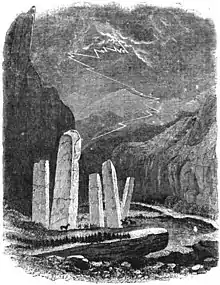Dzungarian Alatau
The Dzungarian Alatau (Mongolian: Зүүнгарын Алатау, Züüngaryn Alatau; Chinese: 阿拉套山; pinyin: Ālātào Shān; Kazakh: Жетісу Алатауы, Jetısu Alatauy; Russian: Джунгарский Алатау, Dzhungarskiy Alatau) is a mountain range that lies on the boundary of the Dzungaria region of China and the Zhetysu region of Kazakhstan. It has a length of 450 km (280 mi) and a maximum elevation of 4,464 m (14,646 ft).
| Dzungarian Alatau | |
|---|---|
 | |
| Highest point | |
| Elevation | 4,464 m (14,646 ft) |
| Geography | |
| Location | Boundary between the Dzungaria region of China and the Zhetysu region of Kazakhstan |
| Climbing | |
| Easiest route | Buses from Almaty |
Features
The Dzhungarian Alatau consists of foothills, ridges, forts, and alpine meadows of the Northern Tian Shan (Trans-Ili Alatau, Ktmen). It is located at an altitude of 2,000m above sea level, and is over 400km long in the latitudinal direction. The Dzhungraian Alatau consists of two ranges that are distinctly parallel to each other: the northern (or main), and the southern range.
The area includes several sub-parallel high mountain ranges, accompanied by low and short ranges and their spurs. It also holds the largest waterfall in Central Asia.
A distinctive feature of the Dzunguarain Alatau is a series of sharp slopes. These are divided into low mountains (700–1600 m), medium lands (1600–3100 m) and highlands (3100–4662 m).[3] There are numerous locations of petroglyphs mainly situated in the low- and mid-hills. The highest peak of the range is Semeonov Tien-Shansky (4622 m).[4]
The area is mostly unexplored. 33 species from the polymorphic genus Allium L. have been found in the area. They belong to the subgenera Rhizirideum, Allium and Melanocrommyum, and are distributed from the foothills to alpine belts.[5]
Tourism
There are two resorts that operate in the area. They are called Tekesu and Tau Zhetisu. Tekeli can be accessed via public transport from Almaty's main bus station to Taldykurgna. From Taldykurdan, marshrutkas are available to reach Tekeli.[6]
The area is often visited by climbers for alpine-style climbing. The area currently consists of approximately 4600 meters on relatively unexplored mountains. At the eastern end of the chain, near the China–Kazakhstan border, lies the Dzungarian Gate, a pass which for centuries was used as an invasion route by conquerors from Central Asia.[7]
References
- Atkinson, Thomas-Witlam (1863). "Travel on the Russian-Chinese borders and in the steppes of Central Asia". Le Tour du Monde: 369–384.
- Lanoye, Ferdinand de (1868). La Sibérie d'après les voyageurs les plus récents. The Library of Congress. Paris, Hachette.
- Kundakbayeva, Zhanat (2007). "Appendix I". The History of Kazakhstan from the Earliest Period to the Present time, Volume 1. ISBN 9785040888788.
- Asia, Kazakhstan, Dzhungarian Alatau, Various Ascents
- Baitenov, Muslim (1995). "Distribution analysis of Allium-L. Species of the Dzhungarian Alatau". Journal of Arid Environments. 30 (4): 397–401. Bibcode:1995JArEn..30..397B. doi:10.1006/jare.1995.0034.
- Dzungarian Alatau
- Frachetti, Michael D.; Benecke, Norbert; Mar'Yashev, Alexei N.; Doumani, Paula N. (2010). "Eurasian pastoralists and their shifting regional interactions at the steppe margin: settlement history at Mukri, Kazakhstan". World Archaeology. 42 (4): 622–646. doi:10.1080/00438240903371270. S2CID 162214549.
